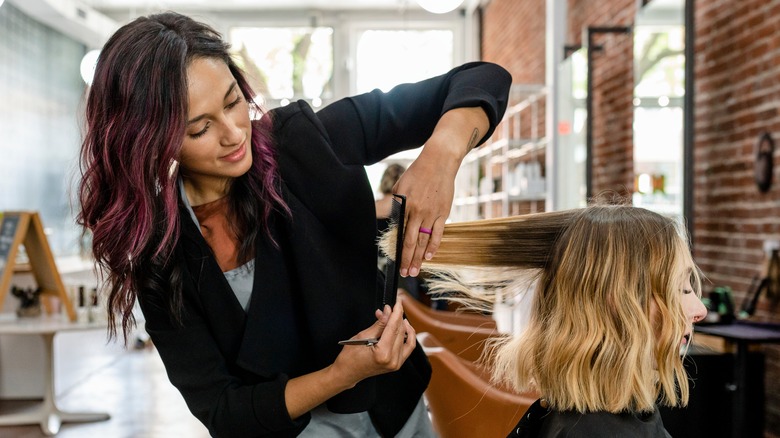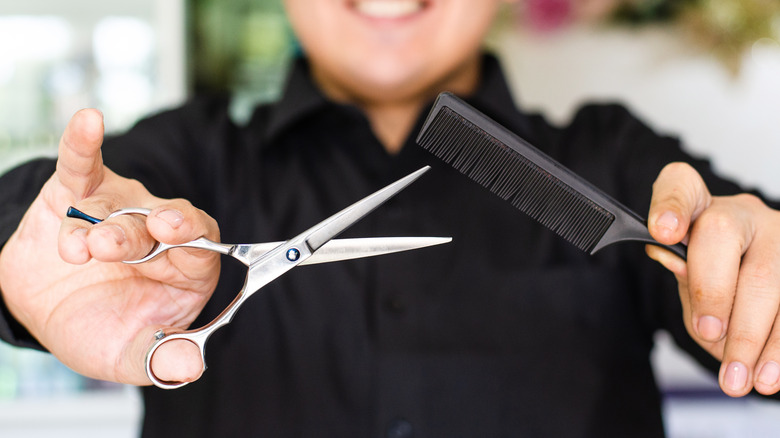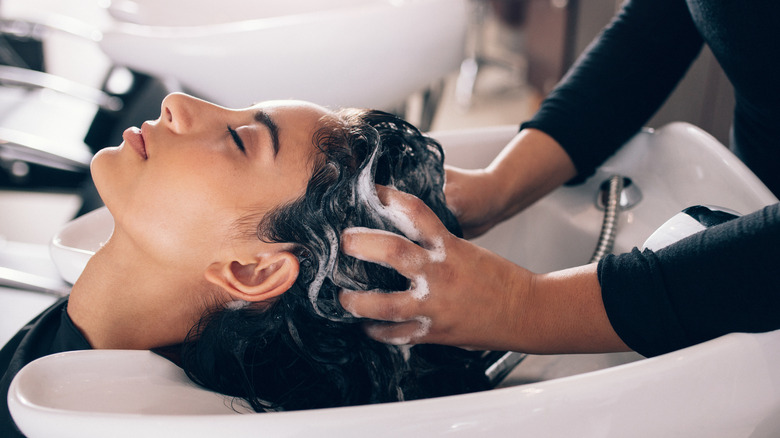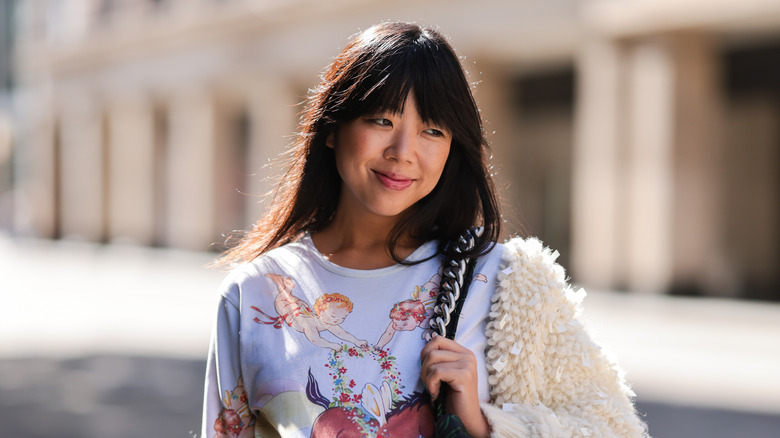What's The Real Difference Between A Cheap And Expensive Haircut?
Not everyone can afford an expensive haircut, and not everyone wants to pay more for a haircut even if they can afford to do so. Add in the fact that visits to a salon might not be accessible or they might lead to added costs (such as for childcare), and it can be difficult to choose what's really worth the time and money.
If you would prefer to save money on your next haircut or if you're wondering if it's worth your while to save up until you can afford a more expensive haircut relative to your usual one, we've gathered what you need to know about the differences between a cheap haircut and an expensive one. Don't forget, salon service prices vary due to many factors, including location and what exactly you'll be getting done. Be sure to do your research prior to booking your next haircut so you know what to expect when you go in for one of the on-trend haircuts everyone will be asking for this year.
Time is a factor
StyleSeat explained that salon pricing is typically related to the time and other resources — such as haircare products — that go into achieving a certain look, so you'll want to keep this in mind when doing your comparison shopping between salons.
Per DMARGE, a relatively inexpensive haircut when compared to other prices in your area could mean that your stylist has a high volume of clients and will be spending less time on your hair. Depending on your haircare needs and your own schedule, this might not be an issue for you, but it is something of which you should be aware.
In speaking with Byrdie, though, color specialist Christopher Fox was adamant that a good stylist should not be in a rush, commenting, "You do, however, need the combination of a good hairdresser and a good salon. What I mean by that is a salon owner (whether hairdresser or not) is key, as this is how the salon is run. You can often find good hairdressers, but the business needs to be set up to allow the time hairdressers need with a client. This can't be rushed to simply get as many clients as possible through the door."
You likely will pay more for a stylist with more training
When looking for the right place to get a haircut, you'll also want to keep in mind the level of training of the stylist. If you're looking to replicate a haircut you've seen on a celebrity, for instance, DMARGE advises against choosing an inexpensive option — simply because a stylist who is charging a low price could have less training to achieve the look you want.
ABC News adds that you could be paying for the reputation of a specific hairstylist, such as a stylist who is known to style hair for celebrities. That said, you shouldn't go off of a stylist's "brand" alone and should do your research into stylists and salons. Christopher Fox told Byrdie, "Look at reviews and images; before and after pictures are ideal. I'd be wary of someone who says they specialize in a certain trend but all the images are of models or celebrities. Whilst it's great to see a few of those for inspiration and to introduce a trend to clients, pretty quickly I'd like to be seeing that specialty shown in a client picture."
Depending on where you live, hairstylists may be required to undergo additional training for the sake of maintaining their licensure, and some salons may require this of their stylists in addition to any wider regulations. Knowing whether this applies to the stylist or salon you're researching could help you in making a more informed decision.
Haircuts are often priced by gender
Like many other things available for purchase in this world, salons may price their haircuts based on whether the client is a man or a woman — even if that language doesn't apply to a client's identity. Though Dazed notes that the state of New York banned salons from pricing services based on gender in 2020, this isn't the case everywhere. Typically, women's pricing is more expensive than men's pricing for salon services, regardless of the length of the client's hair or other factors.
One hairstylist based in Chicago, Illinois, shared with Behind the Chair, "I work for a gender-free, LGBTQ-inclusive salon, and we price based on length of hair AND demand on stylist's time. Newer, less experienced stylists (level 1) have a lower tier than a more seasoned stylist (say, level 3) and prices differentiate between barber style cut, short scissor, chin-shoulder, and collarbone-mid back."
Depending on your hairstyle and gender identity and expression, you might find that a salon's pricing policy is a better value for you, solely based on its gendered pricing, or lack thereof.
You'll pay more for luxury
Beyond paying for the physical haircut itself, paying more for a haircut might mean paying for a more luxurious experience overall (via ABC News). For example, in one salon a client visited for the ABC News story, the service went above and beyond the hair alone, including being offered salads and sandwiches free of charge. Meanwhile, Thrillist reported that at least one Drybar location offers alcoholic cocktails to its clients.
Not every expensive haircut is going to come paired with the equivalent of a Sunday brunch, of course, but paying a premium can come with extra perks, a fact that was also noted by DMARGE in its mention of refreshments and magazines.
More exclusive salons may or may not advertise these additional benefits to prospective clients, though they might be significant enough to lead you to choose a more expensive haircut if they happen to be a draw for you.
An expensive haircut might be noticeable
Finally, though you might not want to pay more for a haircut if you can avoid doing so, it might have its perks for your interactions with others. When comparing two different Los Angeles-area salons with vastly different price points, ABC News found that both the clients used for the experiment were happy with their respective haircuts. At the same time, however, 60% of shoppers at a mall correctly identified which haircut had been more expensive than the other, so this might be something to consider if you are concerned with how others will perceive your haircut.
On the other hand, you can end up with a bad haircut regardless of how much you've paid for it, and it doesn't seem as though even hairstylists themselves pay quite that much attention. Toronto-based stylist Derek Hannah remarked to Chatelaine about expensive haircuts, for example, "I don't know. Maybe there's something I'm missing. I've never paid $300 for a haircut."





